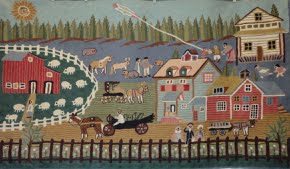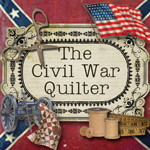
Has anyone ever heard of Signature Plates before? They are new to me. (Click on photo to enlarge.)

Here is one I found recently on eBay. I bought it only because it reminded me of Signature Quilts! It's dated 1894.


All the following blocks are 20th century.
To the left embroidered in blue is a similar signature quilt block pattern from a quilt currently on eBay.
I have found this dealer very reliable over the years. This particular signature quilt is said to come from Central Ohio.

The next Signature Quilt block is again in the wheel-spoke pattern not unlike the plate I found above.
This quilt is from my collection and is dated 1941-42. It actually has a name in the center of each block. It was made in Norfolk, Virginia by Unit No. 5 of the Ladies Auxillary Fleet Reserve Association, although the names come from all over the country.
Only 16 people took the time to add where they were from and most of those 16 were from Indiana. A few from New York and California also mentioned their location. You can read the complete documentation of this quilt in the Quilt Index Signature Quilt Pilot Project here. All 350+ names are transcribed

The quilt to the left and the one that follows are both from the collection of Peggy Gelbrich.

I am now pouring thru my quilt history library to try to find a photo of the earliest Fund Raising Signature quilt done in this embroidered wagon wheel-spoke pattern. I found one dated 1898 in "Nebraska Quilts & Quilt Making" (Crews and Naugle, pg. 120) and two appliqued ones in "For Purpose & Pleasure" (Fox) in the wagon-wheel pattern. One has names embroidered on top of the red appliqued spokes in (pg. 106) dated "late 19th century".
The second quilt appliqued in blue in the same Fox book has the names embroidered in the white fabric between the spokes (pg. 108) and is dated 1898. The size and style of the wheel and spokes on this one is very much like the last block above.....much "fatter" spokes.
Still another appliqued wagon-wheel fund-raiser with names embroidered in the space between the spokes can be seen in "Kansas Quilts & Quilters" (Brackman, Hornback, et al, page 35). This one is dated 1896.
What is the earliest embroidered (non-applique) quilt you have seen in this wagon-wheel pattern?
 |
| How about this for a quilt design inspiration? |
Please leave a comment if you know anything about the history of these plates.
Here are some more details of the plate.























